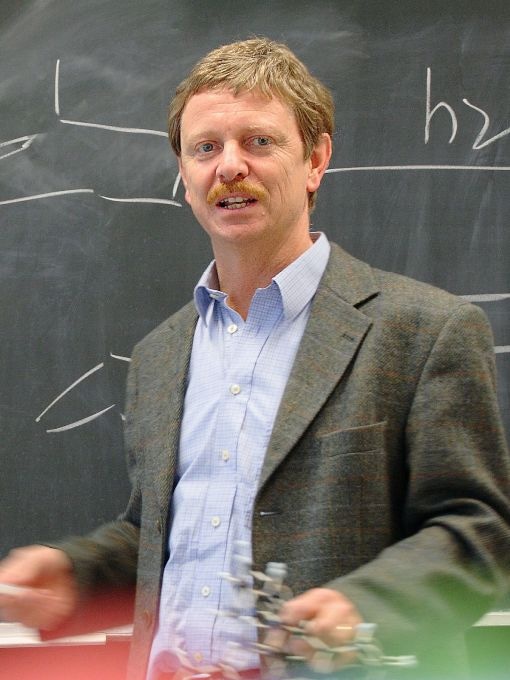Jul 24 2019
Molecules are usually synthesized by utilizing stochastic bond-forming collisions of the reactant molecules present in solution, but nature follows an entirely different method in biochemical synthesis.
 Professor Rainer Herges, Spokesperson of the Collaborative Research Center 677 “Function by Switching.” (Image credit: Rainer Herges)
Professor Rainer Herges, Spokesperson of the Collaborative Research Center 677 “Function by Switching.” (Image credit: Rainer Herges)
Machine-type protein complexes drive most of the biochemical reactions. The reactive molecules are bound and positioned by these protein complexes for selective transformations.
Researchers had proposed artificial “molecular assemblers” executing “mechanosynthesis” as a new example in nanofabrication and chemistry. Now, a group of chemists at Kiel University (Germany) has developed the first artificial assembler that utilizes light as the energy source and performs synthesis.
The novel system integrates precise positioning, selective binding of the reactants, and active release of the product. The researchers have reported their study results in the journal Communications Chemistry.
Molecular assemblers are capable of building molecules. K. Eric Drexler has already proposed the concept of molecular assemblers in 1986, based on notions of Richard Feynman, Nobel Laureate in Physics.
In his book, titled “Engines of Creation: The Coming Era of Nanotechnology” and follow-up publications, Drexler suggests molecular machines that have the ability to position reactive molecules with atomic accuracy and also proposes how to construct bigger and more advanced structures through mechanosynthesis.
If this molecular nanobot is able to construct any type of molecule, then it can certainly develop another copy of itself, that is, it can self-replicate. Such imaginative visions not only inspired several science fiction authors but also triggered an intensive scientific debate.
The Problem of “Sticky Fingers”
In 2003, the debate ended in a cover story of Chemical & Engineering News with the major question: “Are molecular assemblers—devices capable of positioning atoms and molecules for precisely defined reactions—possible?”
Here Richard E. Smalley, winner of Nobel Prize, raised two main objections—the “sticky fingers” and the “fat fingers” problem: In order to grab and guide every single atom, the assembler should have several nano-fingers. Smalley debated that sufficient space is not available in the nanometer-size reaction area to hold all the manipulators’ fingers required to achieve complete control of the chemistry.
The “sticky finger” problem emerges from the fact that the atoms of the manipulator’s hands will bind to the atom that is being shifted. This means, it would be usually impossible to discharge the building block in exactly the right spot. The fat and the sticky fingers issues are important and cannot be prevented, Smalley concluded.
Conversely, nature has various examples of molecular assemblers, for example, ATP-synthase, polyketide synthases, non-ribosomal peptide synthetases, and the ribosome.
In terms of molecular assemblers we can state, if nature is using molecular assemblers for synthesis, chemists should—at least in principle—be able to build and operate artificial assemblers in the laboratory.
Rainer Herges, Professor, Department of Organic Chemistry, Kiel University
Herges is the spokesperson of the Collaborative Research Centre 677 “Function by Switching” at Kiel University.
Along with his team, Herges has now developed the first-ever artificial assembler, which utilizes light as the energy source. Observing nature’s molecular assemblers, the researchers attempted to methodically decrease their complexity and sophistication to a level, attainable with synthetic chemistry. The non-ribosomal peptide synthetases and synthesis of ATP from phosphate and ADP served as models.
Photoswitchable Ligand Guides Through Reaction
They capture the reactants, four vanadate ions, bringing them very close and concatenating them into rings. When the reactants are positioned, they are guided through a particular reaction channel by a photoswitchable ligand, and a molecule is created that does not exist in the starting solution.
The product is also released through the photochemical switching of the ligand to a non-binding state. This helps in solving the “sticky finger” issue. For the external energy source, the researchers selected UV-light because it is easy to apply and no intrusive byproducts are created unlike chemical energy sources.
Analogous molecular machines, like assemblers that condensate amino acids to proteins, are likely to activate a paradigm shift in chemical synthesis. Evident benefits include enantioselectivity, fewer side products, and shorter synthetic pathways because the molecules are forced into a predefined reaction channels by mechanosynthesis.
Moreover, the ring product is higher in energy as the starting material. In other words, light energy is converted to chemical energy. Although Mechanosynthesis with artificial molecular assemblers is extremely challenging, it is worthwhile investigating and could provide a new way for light energy conversion.
Rainer Herges, Professor, Department of Organic Chemistry, Kiel University
The work was supported by the German Research Foundation (DFG) via SFB 677.